Which of the following is not a trend in urban population dynamics?
(a) The number and sizes of urban areas is mushrooming.
(b) Urban growth is much slower in developed countries than developing countries.
(c). Infrastructure is beginning to catch up with the need in developing countries.
(d) Poverty is becoming increasingly urbanized, especially in developing countries.
(e) The proportion of global population living in urban areas is increasing.
Answer: (c)
Which of the following statements is false?
(a) Children in cities have a better chance for education.
(b) Politicians avoid giving services to the poor because this is costly to the cities.
(c) Jobs are difficult to find in cities.
(d) People tend to have more children in urban than in rural environments.
(e) Politicians avoid giving services to the poor because this might attract more people.
Answer: (d)
Which of the following statements is false?
(a) The shift in poverty is moving rapidly from the city to the country.
(b) Developing countries are currently urbanizing faster than developed countries.
(c) Urbanization varies throughout the world but is increasing everywhere.
(d) The general population growth also contributes to urban growth.
(e) The shift in poverty is moving rapidly from the country to the city.
Answer: (a)
To qualify as a metropolitan area, a city must have a population of ____ people.
(a) 25,000
(b) 50,000
(c) 75,000
(d) 100,000
(e) 250,000
Answer: (b)
Check Also: Environmental Science MCQs | Sustainable Development Issues
Which of the following is not a disadvantage of urbanization?
(a) Cities have excessive noise.
(b) Cities lack vegetation.
(c) Cities lack economic opportunities.
(d) Cities have water resource and pollution problems.
(e) Cities are often characterized by urban heat islands.
Answer: (c)
Urban populations occupy about ____ of the planet’s land area, but consume about ____ of the earth’s resources.
(a). 20%; 73%
(b) 4%; 33%
(c) 44%; 88%
(d) 2%; 75%
(e) 40%; 50%
Answer: (d)
Which of the following is not an environmental benefit of urbanization?
(a) Birth rates are lower.
(b) Concentrating people preserves biodiversity.
(c) Cities are self-sustaining.
(d) Recycling is more economically feasible.
(e) People have better access to environmental information.
Answer: (c)
Vegetation improves the quality of life in urban areas by all of the following means, except
(a) Muffling noise
(b) Providing wildlife habitat
(c) Absorbing air pollutants
(d) Warming the air
(e) Reducing soil erosion
Answer: (d)
Sound becomes painful at ____ decibels.
(a) 60
(b) 80
(c) 100
(d) 120
(e) 240
Answer: (d)
Which of the following noises should not cause permanent damage after eight hours of continued exposure?
(a).Lawn mower
(b) Chain saw
(c) Ear phones at loud level
(d) Military rifle
(e).Average factory
Answer: (e)
Which of the following produces the loudest sound?
(a) Jackhammer
(b) Chain saw
(c) Rock music
(d) Military rifle
(e) Truck
Answer: (d)
The most populous city (2017) in the world is ____.
(a) Mexico City
(b) Sao Paulo
(c) Tokyo
(d) New York City
(e) Chongqing, China
Answer: (e)
“Fecal snow” is characteristic of
(a) Sao Paulo
(b) Mexico City
(c) Karachi
(d) Rio de Janeiro
(e). Mumbai
Answer: (b)
Breathing the air of Mexico City is like smoking ____ pack(s) of cigarettes each day.
(a) 1
(b) 2
(c) 3
(d) 4
(e) 5
Answer: (c)
Check Also: Environmental Science MCQs | Sustainable Development Issues
Which of the following is not a proposed way to grow more food in urban areas?
(a) Tearing down blighted areas and turning them into farms
(b) Greenhouses on barges in rivers
(c) Rooftop greenhouses
(d) Hydroponic gardens in glass walls of buildings
(e) Skyscraper farms in 30 story buildings
Answer: (a)
According to a recent Japanese government study of transport in Lahore, ——— of households in Lahore do not own a car.
(a) 64%
(b) 81%
(c) 84%
(d) 74%
Answer: (c)
Location of urban areas is dependent upon the transportation due to major factor
(a) Economies of Scale
(b) Economies of Agglomeration
(c) Comparative Advantage.
(d) All of the above
Answer: (d)
Smart growth does not
(a). Require less dependence on cars
(b) Typically utilize environmental impact assessments
(c) Tax buildings instead of land
(d) Encourage regional planning
(e) Promote high density cluster development
Answer: (d)
Which of the following is not a principle of new urbanism?
(a) Provide increased money for highway improvements to avoid traffic congestion.
(b) Make most places in community within a 10 minute walk.
(c) Provide mixed land uses in a small geographical area.
(d) Emphasize beauty and aesthetics in architectural design.
(e) Create development of land with minimal environmental impact.
Answer: (a)
Which of the following is typically an output of urban areas?
(a) Energy
(b) Raw materials
(c) Greenhouse gases
(d) Grains
(e) Meat products
Answer: (c)
The Millennium Ecosystem Assessment (MA) was released in
(a) March 2004
(b) March 2005
(c) July 2007
(d) September 2017
Answer: (b)
The Economics of Ecosystems and Biodiversity (TEEB) is a study led by
(a) Ahmed Djoghlaf
(b) Pavan Sukhdev.
(c) Herman Mulder
(d) Ladislav Miko
Answer: (b)
The TEEB study was launched by Germany and the European Commission in
(a) 2001
(b) 2004
(c) 2006
(d) 2007
Answer: (d)
Which one of the following is not used for ex situ plant conservation?
(a) Field gene banks
(b) Seed banks
(c) Shifting cultivation
(d) Botanical Gardens
Answer: (c)
Check Also: History of Environmental Thought MCQs | Environmental Science MCQs
Which of the following represent maximum number of species among global biodiversity?
(a) Algae
(b) Lichens
(c) Fungi
(d) Mosses & Ferns
Answer: (c)
Prolonged liberal irrigation of agricultural fields is likely to create the problem of
(a) Aridity
(b) Metal toxicity
(c) Salinity
(d) Acidity
Answer: (c)
An inexhaustible non- conventional universal source of energy is
(a) Wind energy
(b) Solar energy
(c) Hydrothermal energy
(d) Tidal energy
Answer: (b)
Which one of the following expanded forms of the followings acronyms is correct?
(a) IUCN = International Union for Conservation of Nature and Natural Resources
(b) IPCC = International Panel for Climate Change
(c) UNEP = United Nations Environmental Policy
(d) EPA = Environmental Pollution Agency
Answer: (a)
How can the biodiversity can be conserved?
(a) By maintenance of different species
(b) By maintenance of genes of different species.
(c) By maintenance of different Ecosystem
(d) All of the given
Answer: (d)
What can be done by the number of species in habitat ?
(a) Measurement of species diversity in habitat
(b) Measurement of gene diversity of species in habitat
(c) Measurement of interaction of bio communities
(d) Measurement of function of Ecosystem
Answer: (a)
Where the knowledge of biodiversity is applicable?
(a) To study, classification of animals and plants.
(b) To study, Ecosystem
(c) To study, Biogeological region
(d) All the given
Answer: (d)
Which statement is correct for buffer zone of biosphere reserve?
(a) It is legally protected
(b) Authority takes cooperation with local people.
(c) Environmental Education is facilitated by this zone.
(d) Hunting and felling of trees occur in this zone.
Answer: (c)
What is Ecosystem diversity?
(a) similarity of species diversity in Ecosystem
(b) Variation in species diversity in Ecosystem
(c) Mutation in species diversity in Ecosystem
(d) Homozygosity in species diversity in Ecosystem
Answer: (b)
Which one is odd for Amazon rain forest?
(a) Africa (b) Russia
(c) Mauritius (d) Java
Answer: (d)
Animals and plants are used as a food that means…..
(a) Destruction value of biodiversity
(b) Utility value of biodiversity
(c) Ecosystem services
(d) all the given
Answer: (a)
Which is the main cause of extinction of wild life?
(a) Destruction of habitat
(b) Hunting for flesh
(c) Pollution of medicine and water
(d) All the given
Answer: (a)
Which is included in types of biodiversity?
(a) Genes (b) Species
(c) Ecosystem (d) All the given
Answer: (d)
Which is the Hotspot region?
(a) Region which is having volcanoes
(b) Region which is having possibility of earth quake
(c) Coastal region which is having species diversity
(d) Region which is having Tsunami
Answer: (c)
Higher BOD
(a) Lower water pollution
(b) Lesser bacteria in it
(c) More water pollution
(d) More air pollution
Answer: (c)
Which three factors reduce dissolved oxygen levels in water?
(a) High temperatures
(b) Decay of organic matter by bacteria
(c) Respiration by aquatic organisms
(d) All of the above
Answer: (d)
What is the relationship between dissolved oxygen (DO) and biological oxygen demand (BOD)?
(a) High BOD reduces DO as the organic matter decays
(b) High BOD means high DO levels
(c) BOD has no impact on DO.
(d) None of these
Answer: (a)
Check Also: Important Environment Knowledge MCQs (Set-II) | Environmental Science MCQs
What is the original source of energy for almost all living things on earth?
(a) Sun
(b) Soil
(c) Wind
(d) Water
(e) Plant life
Answer: (a)
Which of the following statements best DEFINES energy?
(a) Fossil fuels
(b) Potential and kinetic
(c) The ability to do work
(d) A force that moves something
(e) The rate at which work is done
Answer: (c)
Which of the following is NOT a renewable biofuel?
(a) Wood chips
(b) Petroleum (crude oil)
(c) Ethanol made from corn
(d) Diesel fuel made from vegetable oil
(e) Methane captured from decaying cow manure
Answer: (b)
Petroleum (crude oil) and natural gas come from…
(a) Dead dinosaur remains.
(b) Coal fired power plants.
(c) Large tanks underneath gas stations.
(d) Swamp remains that are thousands of years old.
(e) Plankton and sea life that are millions of years old.
Answer: (e)
The term “renewable energy resources” means resources that…
(a).Are free and easy to use.
(b) Do not produce air pollution.
(c) Are very efficient to use for producing energy.
(d) Can be converted directly into heat and electricity.
(e) Can be replenished by nature faster than they are consumed.
Answer: (e)
Which energy resource is nonrenewable?
(a) Solar
(b) Biomass
(c) Natural gas
(d) Geothermal
(e) Hydropower (water)
Answer: (c)
Which is the most abundant fossil fuel found in the United States?
(a) Coal
(b) Wood
(c) Nuclear
(d) Natural gas
(e) Petroleum (crude oil)
Answer: (a)
Stored energy is called ……. energy.
(a) Wind
(b) Kinetic
(c) Biomass
(d) Potential
(e) Electrical
Answer: (d)

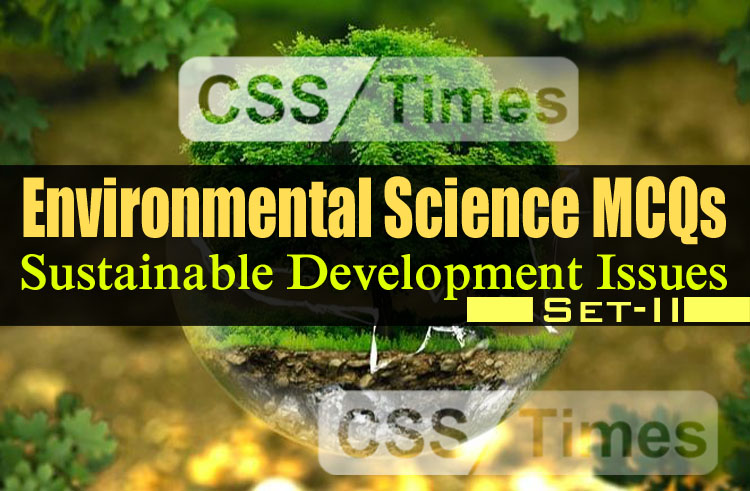

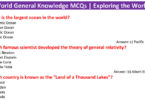
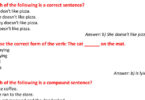
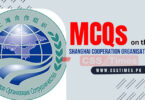
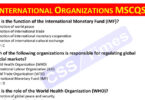
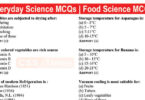
[…] Check Also: Environmental Science MCQs | Sustainable Development Issues (Set-II) […]